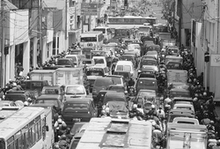Preamble

The purpose of this blog is to contribute to the advancement of urban studies on Indonesia. I was inspired by the success of Urban Planning Research that initiated the scholarly discussions on urban studies through Web log since February 2006.
I am amazed by the power of Web in building and shaping our society. We are now embracing the Information Age and the world will be directed by the citizens of the new digital democracy. The world will not be the same as a few years ago when the power of Web was just about to rise. I agree with Time to choose all of us as the Person of the Year in 2006. Now it's our turn to lead the new world of digital democracy.
My plan is to publish stimulating commentary concerning any urban problem in Indonesia. Why Indonesia?
The simple answer is because there are so many urban problems in Indonesia. Indonesia, the forth largest country in the world with the population of over 220 million, has been experiencing rapid urbanization in the last two decades. This rapid urbanization leads to problems in various aspects in urban life in Indonesia. The economic crisis which hit Indonesia in 1997 exacerbated urban problems in Indonesia. Nearly ten years after being shocked by the crisis, Indonesia has not been fully recovered yet. Unlike China and India, it has been relatively backward in its urban development.
I am encouraged and challeged to contribute in combating urban problems in Indonesia. The complexity and intractability of Indonesia's urban problems need forward-thinking and forward-looking solutions. Through this blog in the new world of digital democracy, I would solicit your opinion to advance urban studies in Indonesia. We will freely communicate our ideas to contribute to making Indonesia's urban spaces better places to live!




4 comments:
A complex many-body problem. That is the analogous problem in Physics to the traffic jam shown in the pic. Every entity interacts with each other as a group. Every body affects every body else. Simplify the interactions by grouping the vehicles and assign dedicated lanes for each type of vehicle. Or reduce the strength of the interaction by reducing the vehicles density per area, i.e. birth control. Or completely redesign the city, I propose to build what I call a disk city: the city has a network of streets that consists of concentric circular streets and radial streets. The city area is then labelled according to the sector (of the disk) where this area is. Every street is a two-way street but with separate lanes for each way. If needed, the second disk of street network can be built above the first disk. So, let's build this disk-city!
Hi Deden,
I just looked at your new blog. It looks like a good start. Now the problem is getting urban studies people to start discussing topics! One way to encourage people to jump in would be to present an initial discussion yourself on some topic that is 'sexy' or even perhaps a little controversial.
As a non-urban studies person, topics that come into my mind (which I do not say are necessarily good topics for you!) are the banning of becaks in some urban centers (did it really improve traffic flow, was this just another example of the government screwing poor people?) use of very dirty engines in the bajajs ( I assume the engines burn dirty, but do they?) and the government's decision to start selling unleaded fuel (has this decision been effectively implemented, has the reputedly record high level of lead in the Jakarta atmosphere been at all reduced in the last decade?). You say in your intro that China and India are more developed in their urban development. I did not realize this. (In fact, I have read a number of articles discussing how awful Chinese cities have become.) Another way to spur commentary might be to take some specific examples of how India
> and China have "better" urban development than Indonesia and discuss why that is. I like the photo of Bandung traffic. Makes you really glad that you are not on that street!
Regards, Pak Mark
Blog yang sangat menyenangkan untuk dibaca karena berwawasan luas dalam urban design, satu topik yang cukup jarang mendapatkan ulasan yang kontinyu. Selamat atas blognya.
see also;
http://www.astudio.id.or.id/artkhus56kota_sustainable.htm
Post a Comment